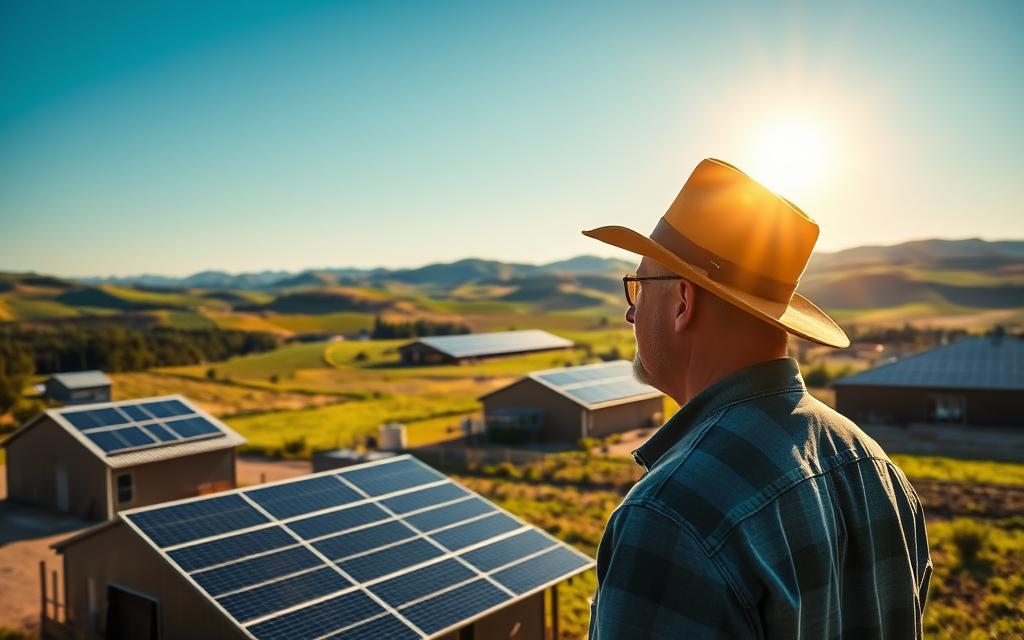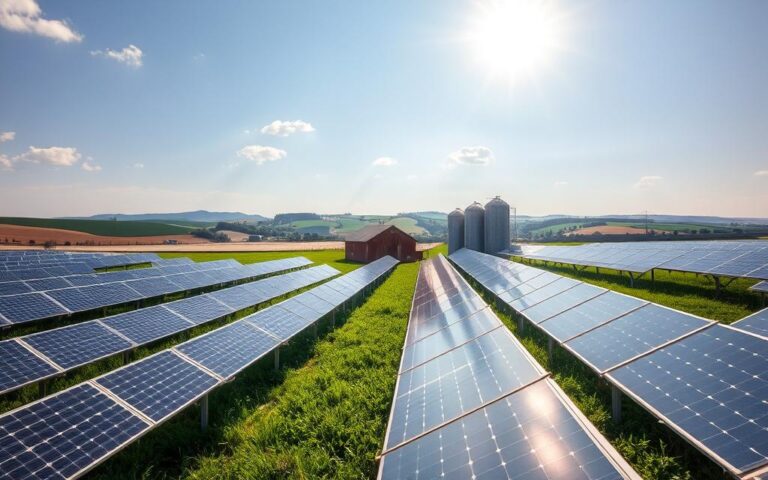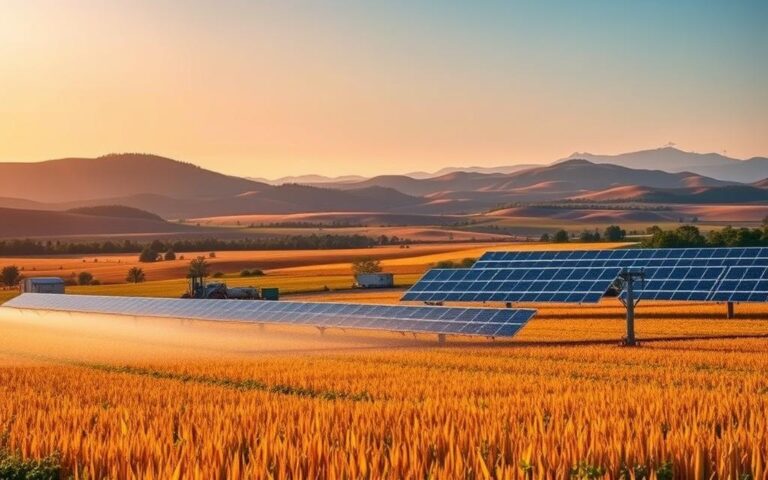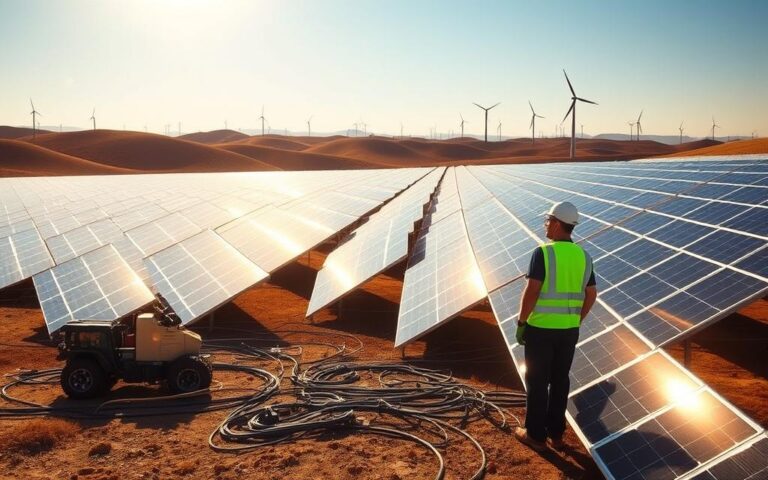Did you know solar energy in farming has grown by over 100% in five years? This big jump shows how solar power is helping farmers in rural areas. They use it to save money and make their farms more sustainable.
By adding solar power, these farmers are making big changes. They’re turning their farms into leaders in innovation and green practices. Thanks to programs like the USDA’s Rural Energy for America Program, more farmers are moving to sustainable energy. This change is key for their success and for taking care of the environment.
Understanding Solar Energy and Its Benefits for U.S. Farmers
Solar energy uses sunlight to make electricity. It’s a green way for farmers to save money. By choosing solar panels, farmers can use less fossil fuel and have a steady energy supply.
Using solar energy helps the planet too. It cuts down on carbon emissions, making farming better for the environment. Farmers save money and are less affected by energy price changes.
Investing in solar panels makes farming more profitable in the long run. Farmers can track their energy use better. As energy costs go up, solar energy provides a reliable option for farming.
In short, solar energy is a smart choice for farmers. It boosts sustainability and financial health. Solar power benefits farmers and the whole country.
The Rise of Solar Solutions for Rural America
Solar energy is becoming more popular in rural America. Federal and state policies are pushing for more renewable energy. This push encourages farmers to try solar solutions.
Many farmers are now using solar energy. It helps them save money and protect the environment.
Federal and State Support for Agricultural Solar Initiatives
Programs like the Rural Energy for America Program (REAP) help farmers. They offer financial help for renewable energy. This includes grants and loans.
These programs make it easier for farmers to switch to solar. It helps them avoid big costs.
Economic Aid and Grants: A Pathway to Solar Adoption
Grants are key in getting solar energy to rural areas. They help farmers pay for the setup. This makes solar energy more accessible.
Thanks to funding, many farms now have solar panels. It shows how important financial support is for solar adoption in rural America.
Case Study: Broadfork Farm’s Transformation
Broadfork Farm in Chesterfield, Virginia, is a shining example of how solar energy can change things. Thanks to federal grants like the REAP program, the farm cut its energy costs and went green. This story shows how money help can lead to better energy choices, helping the planet and the farm’s wallet.
How Federal Grants Impacted Energy Costs
By adding off-grid solar power, Broadfork Farm saved a lot on energy. Janet Aardema, the farm’s co-owner, said they cut their costs by a lot. This money saved lets the farm invest in more green practices.
Environmental and Economic Benefits from Solar Adoption
Going solar at Broadfork Farm has many perks. It cut down on harmful emissions, making the farm more eco-friendly. Plus, saving on energy bills means more money for the farm, helping it grow and stay sustainable.
| Aspect | Before Solar Adoption | After Solar Adoption |
|---|---|---|
| Annual Energy Costs | $15,000 | $7,500 |
| Carbon Emissions (tons/year) | 25 | 10 |
| Investment in Sustainable Practices | N/A | $5,000/year |
This change shows the money benefits of renewable energy. It also points to a bigger trend in the U.S. towards farming that’s good for the planet.
Success Stories from Different States
Implementing solar solutions in rural America has led to great achievements. These stories show how renewable energy can change different areas. From Michigan to Minnesota and Florida, businesses have started using solar energy.
This move has helped them become more sustainable and stable financially.
Michigan’s Lakeshore Die Cast: A Manufacturing Pioneer
Lakeshore Die Cast in Michigan used solar power in their factory. They got help from the Rural Energy for America Program (REAP) for this. This move cut their energy costs and let them sell extra energy.
Now, Lakeshore is a leader for other manufacturers wanting to use solar energy.
Art Thicke’s Dairy Independence in Minnesota
In Minnesota, Art Thicke made his dairy farm energy-independent with solar power. This move helped him save money on energy. It also let him focus more on farming in a sustainable way.
Thicke’s success shows how solar energy can help farmers and make farming more viable.
Florida’s Island Hammock: A Solar-Powered Pet Hospital
Island Hammock in Florida is a vet hospital that runs on solar power. This shows how solar solutions can be used in many ways. It also shows the pet care industry’s commitment to being green.
By using solar energy, Island Hammock saved money and set a good example for other healthcare places.
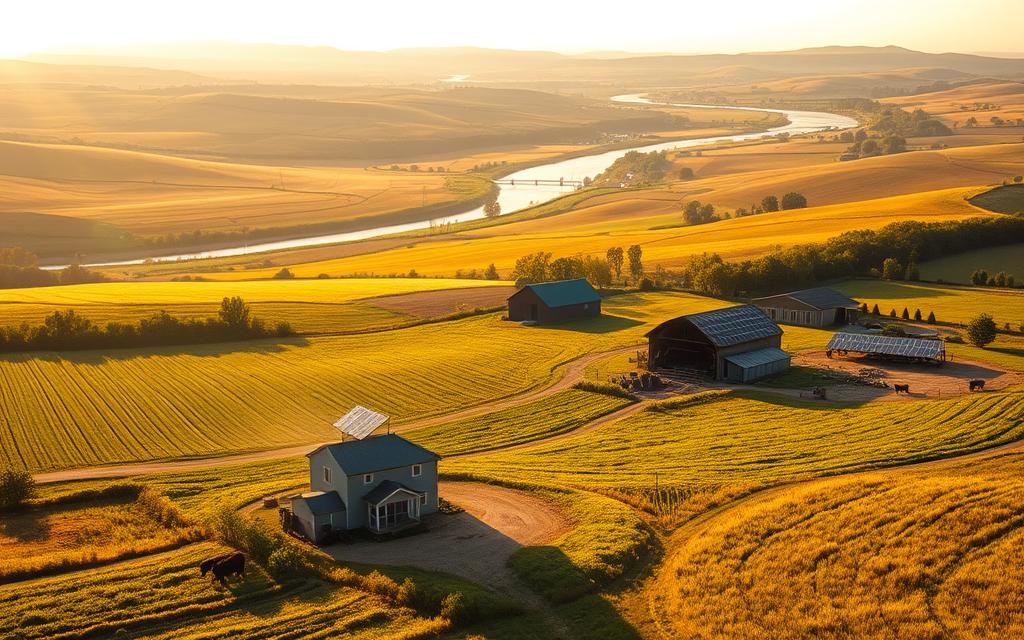
Innovative Projects: Agrivoltaics and Sustainable Farming
Agrivoltaics is a new field that mixes solar energy with farming. It shows great promise for changing how we farm. Jack’s Solar Garden in Colorado is a key example of this new way.
This project shows how solar panels and crops can work together. It supports biodiversity and makes clean energy. Farmers can use off-grid solar power to make their farms more sustainable and profitable.
Jack’s Solar Garden: A Model for Dual-Use Solar Systems
Jack’s Solar Garden is a leader in agrivoltaics. It uses solar panels and crops together. This method gets solar energy and gives shade to crops, which can improve yields and save water.
This approach is seen as a good way to meet our food and energy needs.
The Role of Community Engagement in Agrivoltaics
Getting the community involved is key to agrivoltaic success. Jack’s Solar Garden brings people together. It makes them feel part of sustainable farming.
Workshops and programs teach about agrivoltaics and solar power. This helps the community support these projects. It makes sustainable farming in rural America stronger.
The Future of Renewable Energy in Agriculture
The way we farm is changing fast with the help of renewable energy. Farmers are using new tech to make farming more sustainable. This shift is making farming more productive and environmentally friendly.
Advances in energy storage and smart grids are on the horizon. These could change farming even more. They promise to make farming more efficient and sustainable.
Emerging Technology and its Impact on Farming Practices
New tech is bringing big changes to farming. Energy storage lets farmers save solar power for when they need it. This makes them less dependent on expensive energy sources.
Smart grids help manage energy better. They make sure energy is used where it’s needed most. This makes farming more efficient and cost-effective.
Long-term Viability of Solar Power for Farmers
Solar power is good for farmers in the long run. It saves money and helps them deal with weather changes. Solar power makes farming stronger and more sustainable.
This is good for farmers’ pockets and the planet. It cuts down on pollution and helps the environment. Solar power is a win-win for farmers and the planet.
Challenges Faced by Farmers in Adopting Solar Energy
Switching to solar energy has many benefits, but it also comes with challenges. One big issue is the high cost of setting up solar systems. It’s important for farmers to understand the financial side of solar projects. This part will look at the money side and how to mix solar with traditional farming.
Initial Costs and Financing Solar Projects
The cost of starting up solar can be high, which stops many farmers. The price of panels, inverters, and setup can be a big financial hurdle. But, there are ways to make it easier. Farmers can look into government grants, loans, and tax breaks to help with the cost.
Knowing what financial help is out there and planning ahead can help farmers succeed with solar energy.
Integrating Solar Power with Traditional Farming Methods
Adding solar power to farming is not easy. Farmers have to change their old ways to fit in new tech. This might mean using land differently or changing how water is used to work with solar.
It’s key to find a way that works for each farm. This way, solar can be a real benefit, not just a hassle.
| Financing Options | Description | Advantages | Considerations |
|---|---|---|---|
| Grants | Financial help that doesn’t need to be paid back. | Bigly cuts down on upfront costs. | Can be hard to get; needs detailed applications. |
| Loans | Money borrowed to pay for setup. | Allows for quick start; flexible payback terms. | Includes interest, making total cost higher. |
| Tax Credits | Reduces taxes based on solar investment. | Good way to cut down on costs. | Depends on future tax rules; needs tax liability. |
Advocacy and Education: Promoting Renewable Energy Adoption
Advocacy is key in getting farmers to use renewable energy. Groups like Solar United Neighbors give farmers the tools they need. They offer educational materials and programs to help farmers understand solar energy.
The Role of Organizations like Solar United Neighbors
Solar United Neighbors helps farmers get solar energy. They work on community solar projects and share info on financial help. Their workshops and webinars show farmers the benefits of solar energy.
Farmers get support from a network. This network helps them make the switch to renewable energy.
Resource Toolkits for Farmers Considering Solar Solutions
Resource toolkits are vital for farmers thinking about solar energy. These toolkits have guides on financing, project management, and incentives. They help farmers at every step.
Whether it’s applying for REAP or looking at financing options, farmers feel more confident. They understand how to move forward with solar solutions.
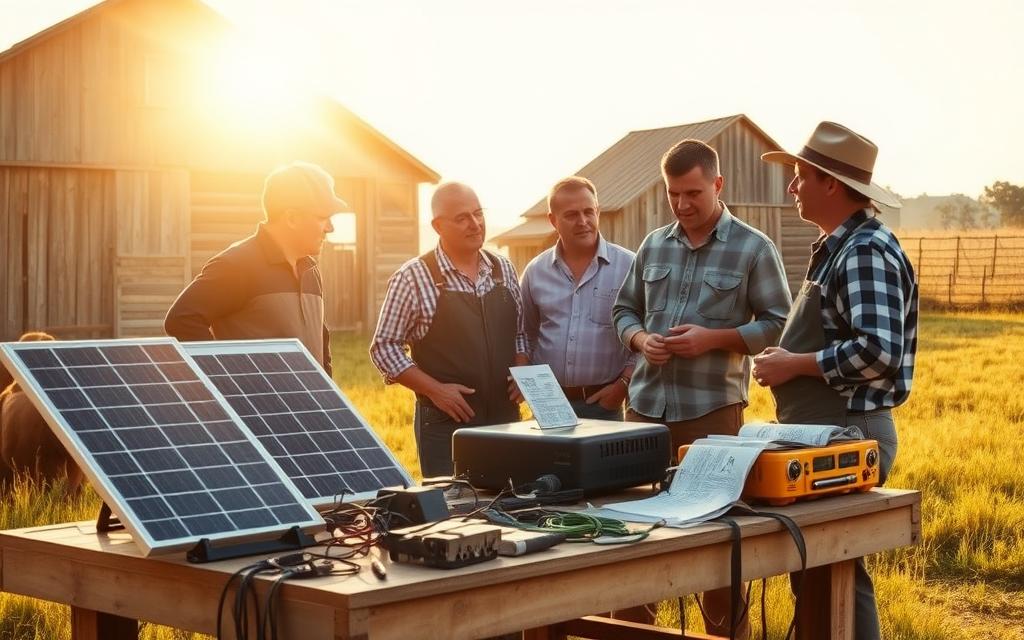
Conclusion
Looking at U.S. farmers who chose solar energy, we see a big change. This change is not just a trend. It’s a move towards farming that’s better for our planet. The stories shared show how solar energy is helping farmers save money, work more efficiently, and make their communities stronger.
These stories also show that using solar energy is good for both farmers and the environment. By choosing solar, farmers are helping to make our future greener. They are showing us how solar power can change farming all over the country.
It’s important to keep supporting farmers as they explore solar energy. Giving them the tools and knowledge they need is key. As more farmers join, farming will become more sustainable and powerful for years to come.

